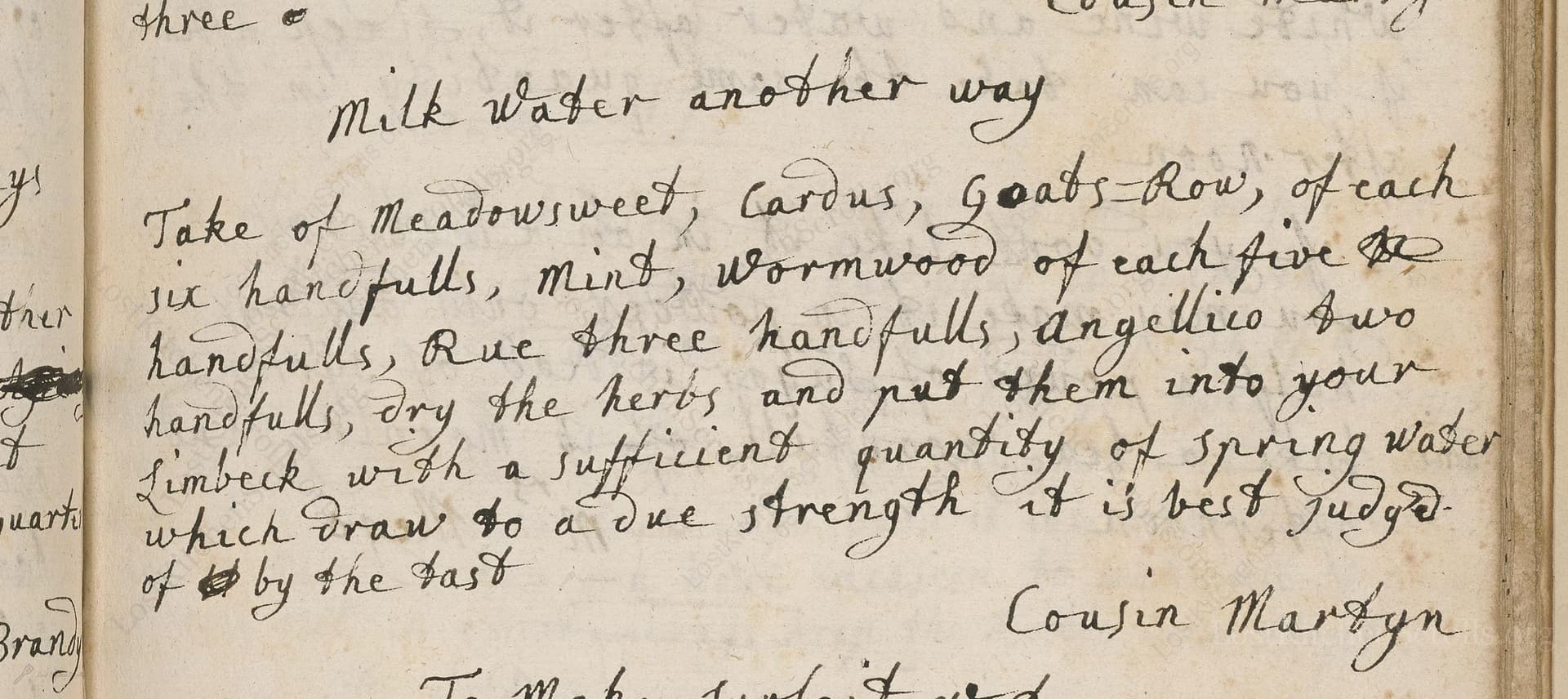Milk Water Another Way
From the treasured pages of Receipt book
Unknown Author

Milk Water Another Way
"Take of Meadowsweet, Cardus, Goats-Row, of each six handfulls, mint, wormwood of each five handfulls, Rue three handfulls, Angellico two handfulls, dry the herbs and put them into your limbeck with a sufficient quantity of spring water which draw to a due strength it is best judgd of by the tast Cousin Martyn"
Note on the Original Text
The recipe is written in the simple, conversational style of early modern English household books: measures are expressed by 'handfuls,' a tactile and subjective unit reflective of domestic practice. Abbreviations are used for plant names (e.g., 'Cardus' for 'blessed thistle'; 'Angellico' for 'angelica'). Spelling varies ('limbeck' for 'alembic,' 'Angellico' for 'angelica'), reflecting the fluid standards of the period. Directions lack precise timings or temperatures, as cooks relied on experience—'best judged by the taste'—to determine readiness. Such recipes expected the reader to bring prior knowledge to the process, making them personal and adaptable.

Title
Receipt book (1700)
You can also click the book image above to peruse the original tome
Writer
Unknown
Era
1700
Publisher
Unknown
Background
A delightful glimpse into the kitchens of the early 18th century, this historic culinary manuscript promises a feast of recipes, remedies, and perhaps a pinch of mystery. Expect both practical fare and elegant inspiration for the curious cook.
Kindly made available by
Folger Shakespeare Library
This recipe hails from around 1700, a time when medicinal waters and herbal distillates were all the rage in English households. Such recipes were often recorded in family books, reflecting both the household’s need for healthful tonics and the era’s blending of culinary and medicinal arts. 'Milk Water' was not made from milk, but named for its gentle, soothing properties—served to restore and revive, especially when one felt 'out of sorts.' Cousin Martyn's inclusion as the source hints at the recipe's passage through networks of trusted kinship and knowledge-sharing among women, who were often the healers of their homes. These waters, redolent with botanicals, were also part of a wider European tradition of cordials and compound waters, prized for well-being as much as taste.

In 1700, the making of this recipe involved a 'limbeck'—an early form of distillation apparatus, often copper, used to extract the herbal essences into water. Other tools included large mortars and pestles for breaking up dried herbs, linen cloths for straining, and glass or stoneware bottles for storage. All processes were powered by open hearth fires, which demanded close attention for gentle, even heat. Modern equivalents would be a copper still or large heat-proof jar for steeping, and fine sieves for filtering.
Prep Time
10 mins
Cook Time
1 hr
Servings
12
We've done our best to adapt this historical recipe for modern kitchens, but some details may still need refinement. We warmly welcome feedback from fellow cooks and culinary historians — your insights support the entire community!
Ingredients
- Meadowsweet, dried – approximately 4¼ oz (6 large handfuls)
- Blessed thistle (Carduus), dried – approximately 4¼ oz (6 large handfuls)
- Goat’s rue, dried – approximately 4¼ oz (6 large handfuls; substitute: dried fenugreek leaves if not available)
- Mint, dried – approximately 3½ oz (5 large handfuls)
- Wormwood, dried – approximately 3½ oz (5 large handfuls)
- Rue, dried – approximately 2 oz (3 large handfuls)
- Angelica, dried root or leaves – approximately 1½ oz (2 large handfuls)
- Spring water – 3 to 4 quarts, enough to cover and distil
Instructions
- To recreate 'Milk Water another way' in a modern kitchen, begin by gathering dried versions of the following herbs: meadowsweet, blessed thistle (carduus), goat's rue, mint, wormwood, rue, and angelica.
- Use the imperial equivalents for the handfuls described (see below).
- Mix the dried herbs together.
- Place them in a large infusion vessel or a copper still (limbeck equivalent), and pour in enough spring water to cover the herbs generously—about 3 to 4 quarts for the quantities below.
- Gently distil or steep the mixture, collecting the first fragrant distillation until the flavor becomes weak.
- Taste frequently to determine when the extraction is just right: aromatic, herbal, and pleasantly bittersweet.
- Strain and bottle the resulting 'milk water' for use as a restorative or cordial.
Estimated Calories
5 per serving
Cooking Estimates
Preparation takes around 10 minutes to measure and mix the dried herbs. The actual distillation or steeping process takes about 1 hour, depending on your equipment. The finished herbal cordial is low in calories, as the herbs are steeped or distilled in water and no sugar is added. This recipe makes about 12 servings of 250ml each.
As noted above, we have made our best effort to translate and adapt this historical recipe for modern kitchens, taking into account ingredients nowadays, cooking techniques, measurements, and so on. However, historical recipes often contain assumptions that require interpretation.
We'd love for anyone to help improve these adaptations. Community contributions are highly welcome. If you have suggestions, corrections, or cooking tips based on your experience with this recipe, please share them below.
Join the Discussion
Rate This Recipe
Dietary Preference
Main Ingredients
Occasions

Den Bockfisch In Einer Fleisch Suppen Zu Kochen
This recipe hails from a German manuscript cookbook compiled in 1696, a time whe...

Die Grieß Nudlen Zumachen
This recipe comes from a rather mysterious manuscript cookbook, penned anonymous...

Ein Boudain
This recipe comes from an anonymous German-language manuscript cookbook from 169...

Ein Gesaltzen Citroni
This recipe, dating from 1696, comes from an extensive anonymous German cookbook...
Browse our complete collection of time-honored recipes



